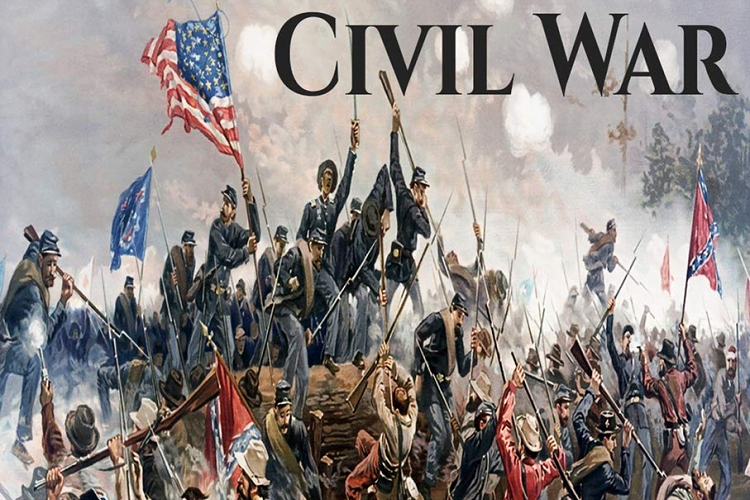The American Civil War stands as a pivotal moment in the history of the United States, shaping the nation’s trajectory in profound ways. Lasting from 1861 to 1865, this conflict tore at the fabric of American society, pitting states against each other and fundamentally challenging the principles upon which the nation was founded.
What caused the American Civil War
Economic Disparities and Regional Divides
At its core, the American Civil War was fueled by deep-rooted economic and social disparities between the Northern and Southern states. The Southern states, heavily reliant on agriculture, particularly cotton production, relied on enslaved labor to maintain their economic dominance. In contrast, the Northern states were experiencing rapid industrialization, leading to a fundamental divide in economic interests.
Political Tensions and States’ Rights
Political tensions over issues such as states’ rights and the expansion of slavery further exacerbated the divide between the North and the South. The Kansas-Nebraska Act of 1854 and the Dred Scott v. Sandford decision of 1857 intensified these tensions, setting the stage for conflict.
Moral and Ethical Considerations
Moreover, the moral and ethical implications of slavery stirred impassioned debates across the nation. Abolitionists in the North condemned the institution of slavery as a moral evil, while proponents in the South defended it as essential to their way of life and economic prosperity.
Key Events Leading to Conflict: A Timeline of Tensions
The American Civil War was the culmination of a series of events and tensions that had been building up for decades. Here are some key events that historians recognize as origins and causes of the American Civil War:
Slavery and Controversy
Slavery arrived in North America alongside the Spanish and English colonists of the 17th and 18th centuries. However, it never existed without controversy. The issue of slavery and its expansion into the western territories became a major point of contention between the North and the South.
Missouri Compromise
The Missouri Compromise of 1820 was an attempt to maintain a balance between free and slave states. It admitted Missouri as a slave state and Maine as a free state, while also establishing a line (36°30′ parallel) that prohibited slavery in the northern territories. This compromise temporarily eased tensions but did not resolve the underlying issues.
Nat Turner’s Rebellion
In 1831, Nat Turner, an enslaved African American, led a violent rebellion in Virginia. This event heightened fears among white Southerners and led to stricter control and repression of enslaved individuals. It also intensified the debate over slavery and its future in the United States.
Wilmot Proviso
The Wilmot Proviso, introduced in 1846, proposed banning slavery in any territory acquired from Mexico during the Mexican-American War. This ignited a fierce debate between the North and the South over the expansion of slavery into new territories.
Compromise of 1850
The Compromise of 1850 attempted to address the issue of slavery in the newly acquired territories. It included provisions such as the admission of California as a free state and the Fugitive Slave Act, which required the return of escaped slaves to their owners. While it temporarily eased tensions, it did not resolve the underlying conflicts.
Uncle Tom’s Cabin
Harriet Beecher Stowe’s novel, “Uncle Tom’s Cabin,” published in 1852, depicted the harsh realities of slavery and its impact on enslaved individuals. The book had a significant impact on public opinion, particularly in the North, and further polarized the nation on the issue of slavery.
Bleeding Kansas
The Kansas-Nebraska Act of 1854 allowed the residents of these territories to decide whether to allow slavery through popular sovereignty. This led to violent clashes between pro-slavery and anti-slavery factions in Kansas, earning it the nickname “Bleeding Kansas.” The events in Kansas foreshadowed the violent conflict that would later erupt in the Civil War.
Dred Scott Case
The Dred Scott case of 1857 was a landmark Supreme Court decision that ruled enslaved individuals were property and not citizens, denying them the right to sue for their freedom. The decision further deepened the divide between the North and the South and intensified the debate over slavery.
Lincoln-Douglas Debates
The series of debates between Abraham Lincoln and Stephen A. Douglas during the 1858 Illinois Senate race brought the issue of slavery to the forefront of national politics. These debates highlighted the stark differences between the two candidates’ positions on slavery and further polarized the nation.
John Brown’s Raid
In 1859, abolitionist John Brown led a raid on the federal arsenal at Harpers Ferry, Virginia (now West Virginia), in an attempt to start a slave uprising. The raid was unsuccessful, but it intensified the tensions between the North and the South and further divided the nation.
Lincoln’s Election and Fort Sumter
The election of Abraham Lincoln as President of the United States in 1860 was a significant turning point. His election was seen as a threat to the institution of slavery in the South, leading several Southern states to secede from the Union. The attack on Fort Sumter in April 1861 marked the beginning of the Civil War.
These events, among others, contributed to the growing tensions between the North and the South and ultimately led to the outbreak of the American Civil War. The war itself was a complex and multifaceted conflict, but these events played a crucial role in its origins and escalation.
The Outbreak of War
The secession of Southern states following the election of Abraham Lincoln in 1860 set the stage for open conflict. The firing on Fort Sumter by Confederate forces in April 1861 marked the beginning of hostilities, prompting President Lincoln to issue a call to arms to suppress the rebellion and preserve the Union.
10 Major Civil War Battles
The American Civil War consisted of numerous battles fought between April 12, 1861, and May 13, 1865, in various states and territories. While it is not possible to provide an exhaustive list of all the battles, here are some notable ones:
- Battle of Fort Sumter (April 12-14, 1861): The first battle of the Civil War, where Confederate forces attacked Union-held Fort Sumter in South Carolina.
- First Battle of Bull Run (July 21, 1861): The first major land battle of the war, fought in Virginia, resulting in a Confederate victory.
- Battle of Antietam (September 17, 1862): A significant battle in Maryland, known as the bloodiest single day of the war, with heavy casualties on both sides.
- Battle of Gettysburg (July 1-3, 1863): A turning point in the war, fought in Pennsylvania, where Union forces successfully repelled Confederate advances.
- Siege of Vicksburg (May 18-July 4, 1863): A Union victory that gave them control of the Mississippi River, splitting the Confederacy in two.
- Battle of Chickamauga (September 19-20, 1863): Fought in Georgia, it was the second bloodiest battle of the war and resulted in a Confederate victory.
- Battle of Atlanta (July 22, 1864): A Union victory that led to the capture of Atlanta, a major Confederate city, and dealt a significant blow to the Confederacy.
- Battle of Fredericksburg (December 11-15, 1862): Fought in Virginia, it was a Confederate victory and one of the Union’s most lopsided defeats.
- Battle of Chancellorsville (April 30-May 6, 1863): A Confederate victory in Virginia, where General Stonewall Jackson was mortally wounded.
- Battle of Appomattox Court House (April 9, 1865): The final battle of the war, where General Robert E. Lee surrendered to General Ulysses S. Grant, effectively ending the Confederacy.
These battles, among many others, played significant roles in shaping the outcome of the war. The American Civil War was marked by a series of engagements, each with its own strategic and historical significance.
The Aftermath: Reconstruction and Legacy
Reconstruction Era (1865-1877)
The Reconstruction era that followed the end of the Civil War witnessed profound social, political, and economic upheaval in the South. Efforts to rebuild the war-torn region and integrate newly freed slaves into society were met with resistance and violence, ultimately shaping the course of American history for generations to come.
Legacy of the Civil War
The legacy of the Civil War endures to this day, serving as a reminder of the enduring struggle for freedom, equality, and justice in American society. From the abolition of slavery to the expansion of civil rights, the lessons of the Civil War continue to resonate in contemporary debates over race, politics, and the nature of democracy.
Conclusion
In conclusion, the American Civil War stands as a defining moment in the history of the United States, shaping the nation’s identity and trajectory in profound and lasting ways. By understanding the complex origins, key events, and enduring legacy of this conflict, we gain insight into the fundamental challenges and aspirations that continue to shape the American experience.
FAQs
What were the main causes of the American Civil War?
The Civil War was primarily sparked by economic disparities, the contentious issue of slavery, and debates over states’ rights.
Who were the major figures involved in the Civil War?
Key players included President Abraham Lincoln, Confederate President Jefferson Davis, and generals such as Robert E. Lee and Ulysses S. Grant.
What were some of the key battles of the Civil War?
Major battles included Gettysburg, Antietam, and Sherman’s March to the Sea, each leaving a significant mark on the conflict’s outcome.
How did the Civil War impact American society?
The war led to the abolition of slavery, the preservation of the Union, and profound social and economic changes during the Reconstruction era.
What lessons can we learn from the Civil War today?
The Civil War teaches us about the importance of compromise, the dangers of division, and the ongoing relevance of its legacy to contemporary issues.
Who won the American Civil War?
The Union, also known as the Northern states, won the American Civil War. They emerged victorious over the Confederacy, the Southern states that seceded from the Union.
How many people died during the Civil War?
Estimates suggest that around 620,000 to 750,000 soldiers died during the Civil War. This staggering loss of life remains one of the most tragic aspects of the conflict.




